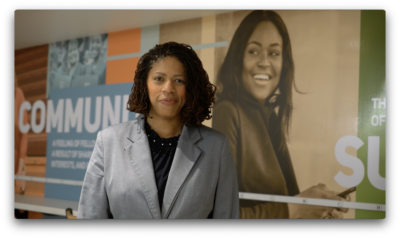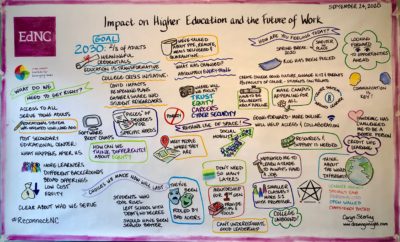

On a recent trip to Black Mountain, my wife and I were hiking when we came across a remarkable sight near a creek. A tree root had somehow burrowed its way through a rock, trying to get to the water. Now it dangled a couple of inches above the ground, a few feet from the water. “So close,” I said, “It almost made it.” “Oh no,” said my wife, “It’s not done yet.”
That moment came just a few days after another that was almost as compelling: watching 17 students from 8 North Carolina colleges gathered around a fire pit on the N.C. State campus talking about hunger in North Carolina.
It’s been a crummy couple of years to be a college student. They’ve fought through infections, online learning, isolation, depression, anxiety. And all that remains real and hard. But many of them are emerging — passionate, optimistic ,and thankful, with a sense that their ideas are valuable, that they can do things to move them forward, and that they should.
The students had come together from across the state to talk about hunger, as part of the eight-month PILOT21 project run by N.C. State’s Institute for Emerging Issues, designed to identify undergraduate students who might want to learn how to work on a big public policy issue. Because of the pandemic, they were meeting in person that night for the first time.
They’d spent the previous two months learning how to collect and use data (thanks to Carolina Demography), doing podcast interviews with experts on hunger, having meetings with campus teams to identify what they knew and what they wanted to work on, and zooming (a lot) with their colleagues from other campuses to develop recommendations for what they might do to reduce hunger.
The idea, supported by the Z. Smith Reynolds Foundation and trustee Jane Smith Patterson, was to try to recreate a project Jane had worked on in the early 1960s — putting energetic college students together to discuss big ideas, and then seeing what happened next.
The morning after they met, they stood up in front of each other, as well as local, state, and federal elected officials and experts on food policy, to share the ideas they had developed. They outlined strategies to help K-12 students get more and better food, ways to increase public-private collaborations, new ideas to support small farmers and reduce food waste. As a policy geek, it made me proud to see them using charts and graphs, arguing from data. As an older person, it made me hopeful to see them standing together; N.C. State students with UNC-Asheville, NCA&T and Duke, Shaw University with Wake Forest, UNC-Wilmington with UNC-Chapel Hill; all vibrating with nervous energy and passion as they made arguments about how we could make our state a better place.
After the presentations, the students voted on one idea they would commit to working on together — in this case, they voted to campaign for a $1 student fee to help fill in food gaps for students missing meals.
This was a critical point in the process: we worried that those with ideas that didn’t “win” would bail on the process. We called for a break so the old people could figure out how to keep the implementation part of the process going.
Another memorable moment: While we wrung our hands in one room trying to figure out next steps, the students went to another, self-organized, and returned to tell us the next steps they had already identified.
“You could feel the energy and innovative ideas coming from all parts of the table,” said Ron Dumas, a senior at UNC-Asheville. “Then we just hashed out the plan so we could have a unified front.”
And they’re off. Despite the pandemic, exams, and worries about the future, one group of students from eight different places are busting through obstacles, looking for food, relentlessly heading toward the water.
They’re not done yet.




